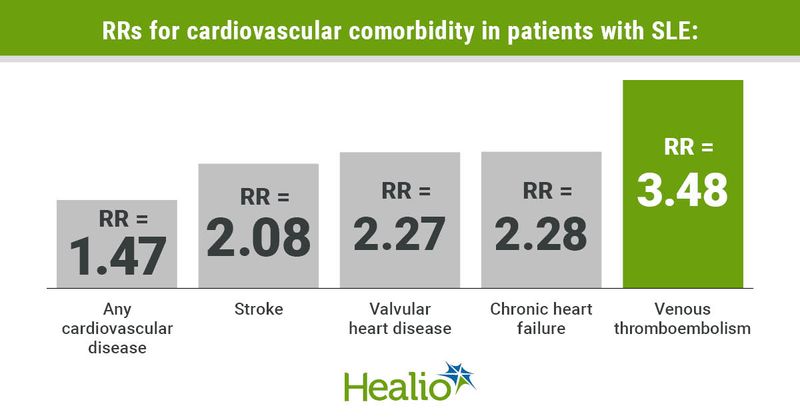Cardiovascular comorbidity risk highest near time of rheumatic disease diagnosis
Key takeaways:
- Patients with lupus and gout had more than twice the risk for several cardiovascular comorbidities.
- The researchers said rheumatic diseases should be considered an “independent risk factor” for cardiovascular diseases.
Among patients with rheumatic diseases, the risk for cardiovascular comorbidity is highest during the period immediately before or after initial diagnosis, according to data published in Seminars in Arthritis and Rheumatism.
“Selected traditional [cardiovascular (CV)] risk factors may be more common among certain rheumatic diseases, but the elevated risk for CV comorbidities is not fully explained by traditional CV risk factors,” Hanna-Kaisa Aaramaa, of Tampere University Hospital, in Finland, and colleagues wrote. “Studies suggest that the risk for certain CV diseases in [rheumatoid arthritis] and [systemic lupus erythematosus] is elevated even before the diagnosis. However, most of the studies provide no information on the temporal relationship between development of CV comorbidity and diagnosis of rheumatic disease.”

To help clarify the risks for cardiovascular comorbidities in patients with rheumatic diseases, and when they are likely to arise, Aaramaa and colleagues analyzed data from FinnGen, a nationwide health care registry in Finland. They included the records of 321,302 patients diagnosed with rheumatic or cardiovascular diseases between January 2000 and December 2014. Each case of rheumatic disease was matched to 20 randomly selected controls. The researchers used logistic regression, adjusted for age and sex, to calculate odds ratios for cardiovascular diseases.
Rheumatic diseases included in the cohort were seropositive and seronegative RA, ankylosing spondyloarthritis, psoriatic arthritis, primary Sjögren’s syndrome, SLE and gout. Meanwhile, cardiovascular comorbidities of interest were major coronary heart disease events, chronic heart failure, atrial fibrillation or flutter, valvular heart disease, venous thromboembolisms and ischemic stroke.
According to the researchers, the RR for any cardiovascular comorbidity ranged from 1.14 (95% CI, 1.02-1.26) among patients with PsA, to 2.05 (95% CI, 1.67-2.52) in those with SLE. Patients with SLE and gout demonstrated more than twice the risk for chronic heart failure, valvular heart disease and venous thromboembolisms, while SLE was also associated with a relative stroke risk of 2.08 (95% CI, 1.2-3.61).
Meanwhile, risks for cardiovascular comorbidities before vs. after the diagnosis of a rheumatic disease were “rather similar” overall, but highest within 1 year of diagnosis with RA, PsA, primary Sjögren’s syndrome and SLE, according to the researchers. Among those with gout, ORs for any cardiovascular comorbidity were “clearly elevated” as many as 10 years prior to gout diagnosis, as well as for 1 year after, they wrote. ORs for any cardiovascular comorbidity were highest within 5 years of a diagnosis of AS.
“Our results emphasize the increased risk for CV comorbidities across all rheumatic diseases very early on in the disease course and encourages to consider rheumatic diseases as an independent risk factor for CV diseases,” Aramaa and colleagues wrote. “Attention should also be given to the elevated risk for [venous thromboembolism] in all patients with a rheumatic condition.”

